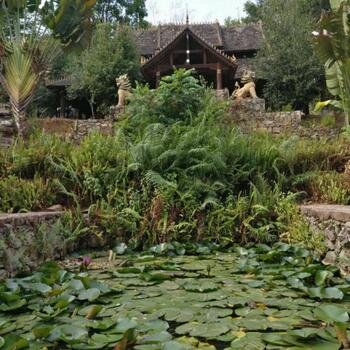
For the Labor Day holiday I head for Yunnan's Myanmar border region. This time not for cycling, but to sample the region's rich tea culture. Together with my tea instructor Mabol and three fellow tea lovers, I travel for a few days from one estate to the next, fueled by an endless supply of tiny cups of tea.

The tea tree Camellia sinensis originated in Yunnan and was first cultivated here for its medicinal properties during the Shang dynasty. Even after thousands of years, tea culture is thriving and still developing. The fermented ripe Pu'er tea called shoucha (熟茶) — pressed into bricks, disk-like cakes or other fancy forms — is a unique Yunnan type that was invented in Menghai (勐海) in 1975. As such, Yunnan can be considered one of the epicenters of tea culture. I'm eager to find out more.

Late in the evening I fly into tiny Lancang Jingmai Airport in Pu'er Prefecture. A driver brings me to the Jingmai Abaila Estate, a gorgeously laid out complex of traditional wooden houses, connected by walkways, and perched on a forested hillside. Early the next morning I am woken by the loud clicking, whirring and chirping of forest insects and birds. We spend a leisurely time sampling different teas from the estate. One of the teas presented looks like little brown granules. Silkworms chew the tea leaves, and what we are drinking is effectively worm poo extract. It's quite delicious.
After tea, we leave our jungle paradise for lunch in Wengji (翁基). Our host is from the Lahu minority, and apart from being an excellent cook, he also turns out to be a great musician. He sings a few Lahu songs for us.

Wengji is a beautiful, small village with traditional wooden houses and a temple, where visitors can get an impression of the old ways of tea processing and buy local products.
Not far from Wengji is a recently built tea temple celebrating the mythical Lahu and Bulang minority founding fathers of tea culture with a gigantic superhero-like statue. We have a rest in the cool interior of the temple and Mabol regales us with stories of tea.

In the evening we pack up and go to the Dai village of Manggeng (芒梗), where we stay at the Budai Family Estate (布傣人家), and get shown around the tea processing facilities by Yiran, the owner. There are fascinating machines that roll the tea, a job that was a labor-intensive process when still done by hand.
On the second day of the tour, we start off even more relaxed than the day before. We share in an al fresco tea ceremony at the ancient Dapingzhang Tea Plantation (大平掌古茶园). Seated on the forest floor, we take turns brewing and pouring tea for each other, learning by watching the true tea masters, Mabol and Yiran.
We explore the ancient tea plantation until it's time to visit Bolian Tea Manor (柏联普洱茶庄园) where we learn how to make our own Pu'er cake. The traditional way requires balancing on a rounded stone and pressing the tea cake dry by dancing on the stone, or rather making awkward hoola-hoop movements.

It's a full day already and it's not finished. We drive on to Menghai and visit the Six Famous Tea Mountains Tea Factory (六大茶山公司勐海厂). Here we enjoy a special tea evaluation. Pu'er tea grown in Yiwu (易武) and Menghai is brewed over increasingly long intervals. We learn how to note the subtle differences between teas with staying power over multiple brews, and an initially impressive flowery tea that fades quickly after the first brew.
Dinner is a Dai feast accompanied by song at the lush Ancient Rainforest Tea Estate (雨林古茶庄园). Exhausted, we roll into Jinghong (景洪), where we spend one night.
From boiling hot Jinghong we travel up to cooler altitudes. A steep road winds around hillsides planted with bananas and rubber trees. These bring us to Yiwu, once one of the nodes on the Ancient Tea Horse Road. Here we get into the bustling vibe of the third annual Tribute Tea Festival. We sample tea at the local tea fair, where local growers present their best brews. It is also market day, and there is a small fun fair with local minority families flooding into town in their traditional best.
On the last day of the excursion, we don't do much apart from drinking more tea in Yiwu, after which it is time to go back to Jinghong for one last Dai-style dinner together. My fellow students and my teacher head back Kunming, while I spend one more day in Jinghong to process and ferment everything I have learned and tasted over the last few days.
I will continue to study tea when I return to Kunming. Having tasted tea grown on estates, surrounded by the lush and peaceful countryside, the names and geographical circumstances are no longer abstractions but good memories, to be savored over a pot of Pu'er tea.
Top image: Unsplash
All other images: Vera van de Nieuwenhof



































Comments
research on origins of C. taliensis (the landrace plant) and the probable domesticated C. sinensis bmcplantbiol.biomedcentral.com/[...]
Note that the Shang Dynasty, as a political force and administration, had nothing whatsoever to do with anything in today's Yunnan Province, although the time of its existence in north China may well have been that of the first cultivation of tea for medicinal purposes here by people who were in no sense 'Chinese.'
Sounds like it must have been a pleasant excursion.'
Fascinating stuff, Jingster.
@daojingster: Damn - science!
No evidence of cultivation during Shang times, however, though I guess it could have happened.
Buy as much tea as possible straight from the shelves of those families, its about the closest a client can get to not buy fake stuff. But even in Yiwu faking is big, but if u can pick it from the shelf of a family, then go for it. Buy it "raw" let it mature 5-8 years, oh, that liquid gold is amazing to drink. Enchances creativity too.
I could think of better things for that mate and you wouldn't have to wait 8 years
@Ishmael, Due to the very far distance to ancient central goverment, Yunnan was seldom wrote in any book or writings. Most of the places in Yunnan even did not have a name till Han dynasty. However, there is a book named《华阳国志.巴志》wrote by常璩 in East Jin dynasty that ;By leading Bashu army to crusade again Emperor Zhou of Shang in1066 BC, Emperor Wuwang Zhou won, and was tributed herb medicine,honey, tea, etc. Among the armed forces, there was Pu people, who are the ancestor generation of Bulang, Hani, De'ang and Wa minorities,who discovered and domesticated tea(周武王伐纣,实得巴蜀之师......丹漆茶蜜,皆纳贡之).
Now there are vast evidents prove that Yunnan is the origin of world tea, andat least 1300 years ago, there have already cultivated tea plantations existed in large scales. Now you are still able to visit the cliff painting in Cangyuan, Lincang, wrote about the tribe life 3000 years ago, concluding tea.
Watch this vedio, you will have better understand about Yunnan tea: www.youtube.com/watch?v=oyNX1NNR-iw&t=17s
And you are welcomed to join my tea course and the endless tea journey 2 :)
@ vicar
I didn't have to wait 8 years. Years passed by in a rush and there they were, all the puer cakes i bought 2006-2010 dark and ready. Knowing they are not fake is a big plus. I doubt u can find a tenner that isn't fake.
Buy now 2027 is just around the corner.
I have lot of stuff still in china, but all puer cakes are rescued and safely in europe.
Login to comment